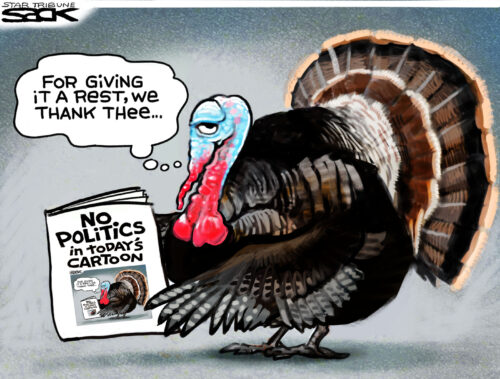Join Health Affairs for a virtual conversation between me and Angela Odoms-Young of Cornell University discussing the evolution of US food and nutrition policy, the current policy landscape, and thoughts on what lies ahead. It’s at 1:00 p.m. EDT. To join the Webinar, register here.
The State of Obesity, 2020: no downturn in prevalence
Trust for America’s Health has just issued its annual report on obesity in America.
The full report is here.
The results are truly alarming, especially because obesity—and the conditions for which it increases risk—also increase the risk of poor Covid-19 outcome.
The U.S. adult obesity rate stands at 42.4 percent, the first time the national rate has passed the 40 percent mark, and further evidence of the country’s obesity crisis. The national adult obesity rate has increased by 26 percent since 2008…Rates of childhood obesity are also increasing with the latest data showing that 19.3 percent of U.S. young people, ages 2 to 19, have obesity. In the mid-1970s, 5.5 percent of young people had obesity.
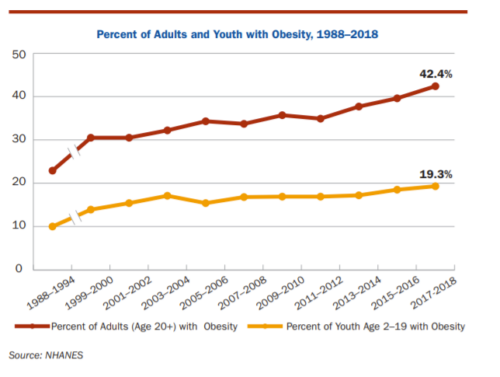
The report has a special section on the link between food insecurity and obesity.
Food insecurity and obesity have many of the same risk factors (e.g., income or race/ethnicity) and often coexist in populations. Researchers have hypothesized several mechanisms for how food insecurity might lead to obesity. These include the direct limitations to a healthy diet that come from inadequate food affordability and/or availability; stress and anxiety about food insecurity
that generate higher levels of stress hormones, which heighten appetite; and a physiological response in which the body stores higher fat amounts in response to reduced food availability.
As always, this is a terrific source of current information about America’s increasingly prevalent health problem and what’s being done—and needs to be done—to solve it.
Digital marketing to children: two reports
The thing about digital marketing to kids is that parents hardly ever see it. And it works. Really well.
The first report comes from the Public Health Advocacy Institute at Northeastern.
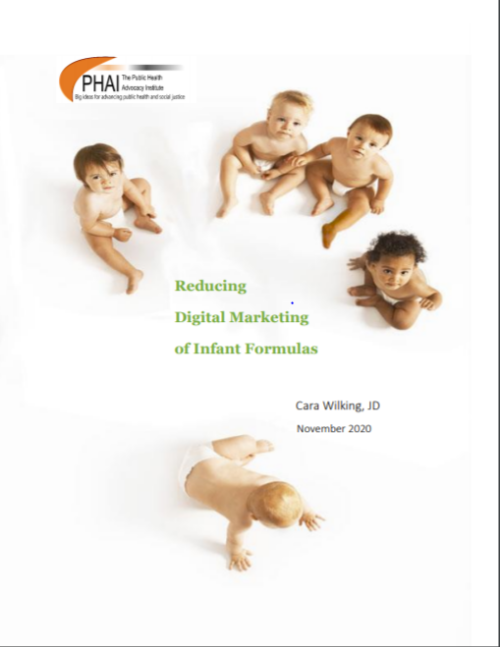
The report comes with three issue briefs.
The second report comes from public health advocates in Australia, also about digital marketing on kids.
- Their report is here.
- Don’t miss the 30-second video that goes with it. Creepy.
All of this is really happening. Advocates: get to work!
Industry-funded study of the week: dairy foods and child growth
Growth and Development of Preschool Children (12–60 Months): A Review of the Effect of Dairy Intake. David C. Clark, Christopher J. Cifelli, Matthew A Pikosky. Nutrients 2020, 12(11), 3556; https://doi.org/10.3390/nu12113556
Weekend reading: Deborah Madison!
Deborah Madison. An Onion in My Pocket: A Life with Vegetables. Alfred A. Knopf/Borzoi, 2020.
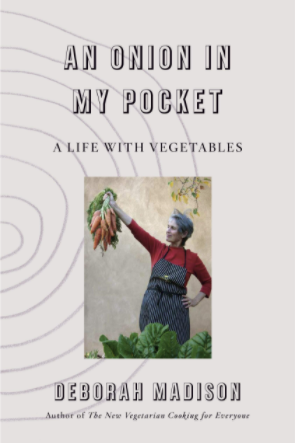
Here’s my back-of-the-book jacket blurb:
Onion in My Pocket is a riveting account of how Deborah Madison’s previous 20-year incarnation as a serious student of Zen Buddhism prepared her to become the consummate vegetarian cook and cookbook writer. We are all fortunate that she loves vegetables—and healthier as a result.
Madison is the author of more than a dozen books about vegetarian cooking. She opened Greens in San Francisco, a restaurant that moved vegetarian cooking from the fringe to the mainstream. Going there—or to Tassajara–during the heyday of the San Francisco Zen Center was a sublime culinary experience, well worth the long wait to get in.
Of her time at Greens, Madison writes:
At that time I had a tendency to cook richly, using plenty of butter, eggs, and cream when it made sense. I was unsure about bringing vegetarian food into a mainstream venue, and I knew that we could always make something good when we relied on cream or buttery crusts, and that customers would like them. Fat was easy to fall back on in this way. Also this was 1979 and the early 1980s, an era of cream, butter, and cheese–not just at Greens but in restaurants everywhere. Our dinners were rich, celebratory splurges, not substitutes for home cooking. I can’t tell you how many people have told me they were proposed to at Greens, or got married there.
No wonder the food was so good!
Her cooking now is lighter, but still wonderful.
In Onion, Madison is too polite to mention what was happening at the Zen Center at the time she left to cook at Chez Panisse and explore the wider world. That story—a #MeToo forerunner–is covered in Michael Downing’s “Shoes Outside the Door: Desire, Devotion and Excess at the San Francisco Zen Center.”
This book is about discovering the deliciousness of vegetables. We need it.
Retailers should promote health eating: Here’s how.
I was sent a press release announcing a set of research papers on retail strategies to improve healthy eating. Most people buy food at supermarkets, but supermarkets are not public health agencies. They are businesses with one purpose: to make money for owners and stockholders. As I discussed in my book, What to Eat, they are designed to keepyou in the store as long as possible so you will have plenty of time to impulse-buy. These papers in the International Journal of Environmental Research and Public Health discuss ways retail food stores could help diets get healthier.
They come with a new report outlining a research agenda for retailers. All of this was funded by Healthy Eating Research, a national program of the Robert Wood Johnson Foundation in partnership with the Center for Science in the Public Interest (CSPI), the Johns Hopkins Bloomberg School of Public Health, and The Food Trust.
The full issue of the journal is here.
Special issue: Retail Strategies to Support Healthy Eating
- Developing A National Research Agenda to Support Healthy Food Retail
By Amelie A. Hecht, Megan M. Lott, Kirsten Arm, Mary T. Story, Emily Snyder, Margo G. Wootan and Alyssa J. Moran - Urban vs. Rural Socioeconomic Differences in the Nutritional Quality of Household Packaged Food Purchases by Store Type
By Allison Lacko,Shu Wen Ng and Barry Popkin - A Model Depicting the Retail Food Environment and Customer Interactions: Components, Outcomes, and Future Directions
By Megan R. Winkler, Shannon N. Zenk, Barbara Baquero, Elizabeth Anderson Steeves, Sheila E. Fleischhacker, Joel Gittelsohn, Lucia A Leone and Elizabeth F. Racine - Healthy Food Retail during the COVID-19 Pandemic: Challenges and Future Directions
By Lucia A. Leone, Sheila Fleischhacker, Betsy Anderson-Steeves, Kaitlyn Harper, Megan Winkler, Elizabeth Racine, Barbara Baquero and Joel Gittelsohn - Understanding the Intersection of Race/Ethnicity, Socioeconomic Status, and Geographic Location: A Scoping Review of U.S. Consumer Food Purchasing
By Chelsea R. Singleton, Megan Winkler, Bailey Houghtaling, Oluwafikayo S. Adeyemi, Alexandra M. Roehll, JJ Pionke and Elizabeth Anderson Steeves - Improving Consumption and Purchases of Healthier Foods in Retail Environments: A Systematic Review
By Allison Karpyn, Kathleen McCallops, Henry Wolgast and Karen Glanz - Associations between Governmental Policies to Improve the Nutritional Quality of Supermarket Purchases and Individual, Retailer, and Community Health Outcomes: An Integrative Review
By Alyssa J. Moran, Yuxuan Gu, Sasha Clynes, Attia Goheer, Christina A. Roberto and Anne Palmer - Influence of Food and Beverage Companies on Retailer Marketing Strategies and Consumer Behavior
By Amelie A. Hecht, Crystal L. Perez, Michele Polascek, Anne N. Thorndike, Rebecca L. Franckle and Alyssa J. Moran - (Publication Pending) Supermarkets in Cyberspace: A Conceptual Framework to Capture the Influence of Online Food Retail Environments on Consumer Behavior
New report: Big Food vs. Public Health During the Pandemic
Here’s a new must-read report:
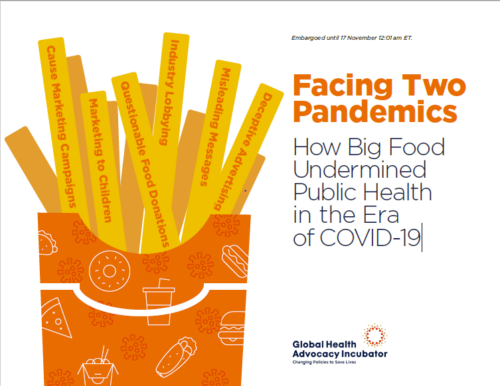
This is a thorough and carefully done analysis of the ways in which Big Food companies took advantage of the Covid-19 pandemic as a marketing opportunity. The report gives more than 40 specific examples of corporate:
● Nutri-washing: Coupling “solidarity actions” with aggressive marketing of junk food and sugary drink brands, which helped polish corporate images
● Positioning ultra-processed food and drinks as “essential products” when they are not healthy foods
● Playing both sides: Carrying out philanthropic actions while actively lobbying against healthy food policies
● Using charity to push junk food: Donating ultra-processed food and drinks to vulnerable populations
Here’s just one example:
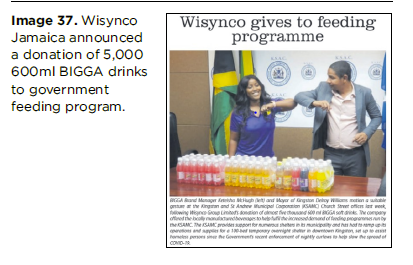
The report is short and beautifully designed. It comes from the Global Health Advocacy Incubator. This group produces tools for advocacy, among other useful items.
As Bettina Siegel wrote earlier this year.
America’s poor diet is the leading cause of poor health and is responsible for more than half a million deaths per year. And if our current comfort food bender demonstrates anything, it’s that when people’s sense of security is fundamentally threatened, they’re very often compelled to seek relief and pleasure in unhealthy food.
The report shows how food companies take advantage of our current vulnerabilities. That’s another reason why the UK’s stop-marketing proposal (I wrote about it yesterday) is so badly needed.
Let’s hear it for good food news: the British government wants to ban junk food marketing
Here’s the announcement in The Guardian: “UK to ban all online junk food advertising to tackle obesity: ‘World-leading’ proposal delights health campaigners and dismays advertising industry.”
The tougher-than-expected rules came after Boris Johnson changed his view on personal health decisions following his coronavirus infection. Overweight people are at risk of more severe illness from Covid, or death. Research has found that one in three children leaving primary school are overweight, or obese, as are almost two-thirds of adults in England…If implemented, the ban would affect digital marketing, from ads on Facebook, to paid-search results on Google, text message promotions, and social media activity on Twitter and Instagram.
This refers to the UK government’s “New public consultation on total ban of online advertising for unhealthy foods.” The details of the consultation are here. The government wants comments on
- what types of advertising will be restricted
- who will be liable for compliance
- enforcement of the restrictions
The plans will now be discussed by representatives from the food industry, members of the public and the government for six weeks, before a decision is made over whether the advert ban will happen or not.
Comment: I’ll bet this proposal does indeed ‘”dismays the advertising industry” and the food industry too. Marketing is an enormous influence on food choice, particularly insidious because we don’t recognize marketing as such. It’s just seen as part of the landscape and affects us at an unconscious level. Marketing to children is especially egregious, especially because it is so effective in encouraging them to demand junk food. Cheers to the UK government for this. Stick with it!

